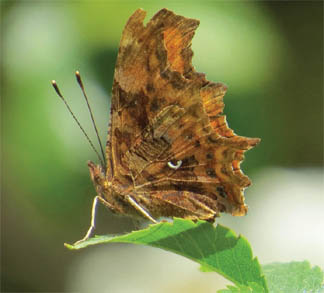| Wildlife
Newsletter for the Township of Dalkey November 2015 - Michael Ryan |
|
|
Visiting
Carlow We’d never been to Altamont Gardens in Carlow and when we did eventually go on a day in August it didn’t look too promising. On the day before Carlow had recorded the highest temperatures in the country but the morning when we set off was dull and overcast. Still, the air was warm enough to get two individual Buzzards and a Red Kite drifting across the sky beside the motorway as we headed towards Wexford and then as we neared the village of Ballon approaching the gardens another red kite flew by. The rain arrived as we reached the gardens but we went to the tea shop and by the time we came out the sky was brightening and the clouds clearing away. As is often the way when the sun reappears after a shower the wildlife becomes activated and in the formal gardens a Spotted Flycatcher flew from a perch in a conifer, on little sorties to grab insects while a Song Thrush fed on the season’s new crop of yew berries. As we walked around the ornamental pond we heard a buzzard calling and then three of them appeared drifting over the trees. |
|
There’s
a very impressive collection of trees in the arboretum including some
red oaks whose leaves will soon turn into one of the most spectacular
colours of autumn. By the time we’d walked by the river and circled
the garden we thought we’d still have time to take in another
garden and maybe another tea shop and one of Altamont’s gardeners
suggested we try Huntington Castle in Clonegal which was only a few
minutes away and on our return route. It had turned into a sunny, very
pleasant afternoon by this stage. The tea shop at Huntington is in the
corner of a big courtyard and the outside tables and seating in the
sun looked very promising but the girl serving in the shop warned us
there were lots of wasps out there. We ignored her advice, tried an
outdoor table anyhow but had barely sat down when we were joined by
some very busy wasps and we retreated back indoors. The humid still
air buzzed with flying insects and when we entered the garden the first
border we saw was busy with butterflies feeding on a buddleia. But it
was on the adjoining plant that I had my first ever Irish sighting of
a butterfly that would have been unknown in Ireland two decades ago,
the Comma. The comma’s wings have a very ragged appearance compared
to most butterflies but there’s a good reason for that since the
adults hibernate and, with wings folded, resemble a dead leaf, camouflage
against predators. They get their name from a small white comma mark on their underwing a further camouflage adaptation to give the impression of a hole in the ‘leaf’. Apparently their ‘caterpillars are black and orange with a white streak along their back, which gives them the appearance of a bird dropping’ so they seem to be real masters of disguise. Commas have only begun to be seen in South East Ireland in recent years and at the moment Butterfly Conservation Ireland are carrying out a survey collating sightings to see how far the Comma has moved into the country. Jesmond Harding of Butterfly Conservation Ireland informed me ‘The Comma was sighted first in the ROI by Elizabeth Kehoe on 17 August 2000; Elizabeth was then 16. It was not sighted again until 19 September 2005 and sporadically until about 2011 when it began to be seen regularly by Andrew and Brian Power in Cuilaphuca Wood, Carlow. In the past two years much larger numbers than the single figures seen up to 2011 have been recorded.’ I’d been lucky to see them on two previous occasions but that was in the British midlands and it was wonderful to see this new, welcome arrival to our shores which now looks like it might become a permanent residence. They seem to be extending their range into northern England and Scotland as well,possibly a result of global warming. |
||
This
particular individual comma gave us great views then Lucy saw what had
just arrived on the adjoining buddleia in the ornamental border. In
last month’s article I mentioned our excitement at seeing a Hummingbird
Hawk-Moth in Dalkey Quarry and here was another one, a blur of wings
as it hovered in front of the buddleia’s flowers. We had two spectacular
migrants within feet of us giving us great views but we still had the
gardens to see which include what is claimed to be the tallest Fir in
Carlow as well as their Gingko trees, the oldest known species of tree
described as a ‘living fossil’ being the sole survivor of
an ancient group of trees older than the dinosaurs, the oldest recorded
individual being an astonishing 3,500 years old. . The tree-lined paths and calm pools were a haven of quiet then we heard a sound that’s getting increasingly common in Ireland, the ’whick’-like call of a Great Spotted Woodpecker. I notified BirdWatch about this one and apparently they had been already reported, possibly nesting, nearby. Later I realised that among the interesting species we’d seen and heard that day, the buzzards, the red kites, the comma butterfly, the hummingbird hawk-moth and the woodpecker, the moth - itself a summer migrant - was the only one of those creatures you would have seen in Ireland 20 years ago. Although the red kites were reintroduced the rest of those species have all made their way here by natural expansion and all are a welcome addition to our environment |
 Comma Butterfly - the small white mark on its underwing gives the Comma Butterfly its name Photos: M. Ryan |